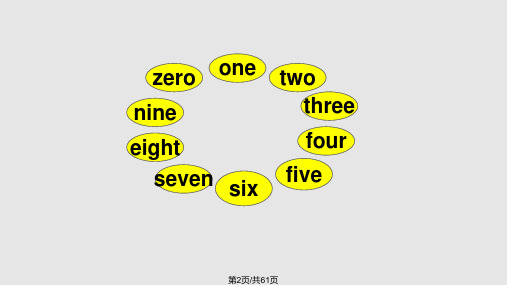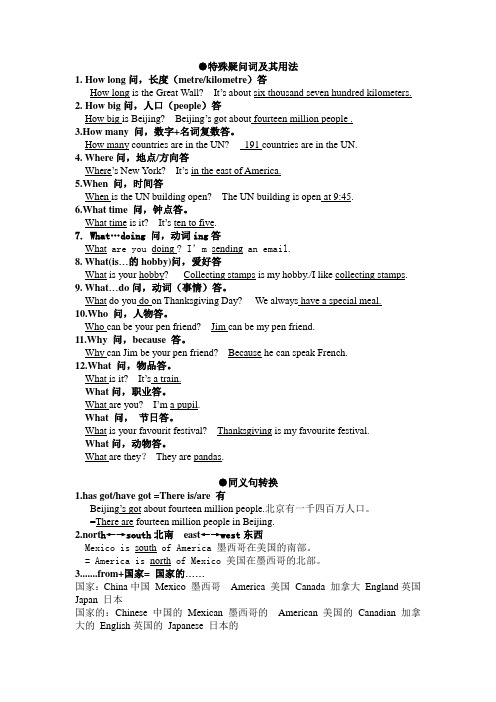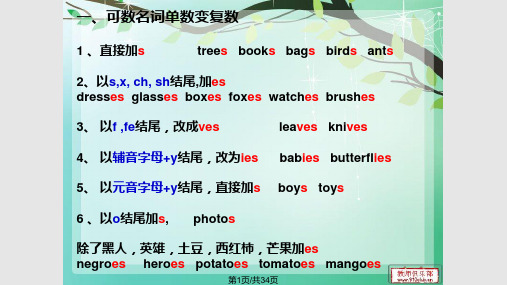小学英语语法共32页
小学英语语法大全(完整版)(可打印)

小学英语语法大全第一章名词一、定义名词是表示人或事物名称的词。
它既可以表示具体的东西,也可以是表示抽象的东西。
二、分类1. 名词可以根据意义分为普通名词和专有名词如:john is a studentstudent是普通名词,john是专有名词普通名词前可以用不定冠词a/an, 定冠词the 或不加冠词,专有名词前一般不加冠词,专有名词的首字母要大写。
2. 普通名词又可以分为个体名词、集体名词、物质名词和抽象名词,其中个体名词与集体名词是可数名词,物质名词和抽象名称是不可数名词。
3. 专有名词专有名词是表示人名、地名、团体、机构、组织等的专有名词,多为独一无二的事物。
三、名词的数1、名词分为可数名词和不可数名词。
可数名词——可以数的名词不可数名词——数不清(没有复数)drink?milk tea water orange juice coke coffee porridgefood?rice bread meat fish fruit cake dumplings2、可数名词与不定冠词a(an)连用有数数形式,不可数名词不能与不定冠词a(an)连用,没有复数形式many+可数名词复数much/a little+不可数名词some, any , a lot of (lots of) 两者都可以修饰。
3、可数名词可以直接用数词来修饰不可数名词数词 +量词 +of + 名词对可数名词的数量提问用how many对不可数名词的数量提问用 how much4、不可数名词的量有以下两种表示方法:1) some, much ,a little ,a lot of ,a bit of , plenty of 用等表示多少。
注意既可以与可数名词复数,又可以与不可数名词连用的有:plenty of ,some ,a lot of ,lots of ,most of 等。
如there is much water in the bottle .瓶中有很多水。
小学英语语法系列基数词序数词详细讲解下载

seven six
two three four
five
第2页/共61页
zero one two
nine numbers
eight
three four
seven six five
第3页/共61页
最基本的数词如下:
• 1 one, 2 two, 3 three, 4 four, 5 five, 6 six, 7 seven, 8 eight, 9 nine, 10 ten, 11 eleven, 12 twelve, 13 thirteen, 14 fourteen, 15 fifteen, 16 sixteen, 17 seventeen, 18 eighteen, 19 nineteen, 20 twenty, 30 thirty, 40 forty, 50 fifty, 60 sixty, 70 seventy, 80 eighty, 90 ninety,
ten sixty
thirty
forty
seventy
One hundred
eighty
fifty
ninety
twenty
第16页/共61页
Dragon
•1-100
第17页/共61页
Look and Read
100
1
one hundred
1,000
2
one thousand
3
1,000,000 one million
1,000,000,000
4
one billion
第18页/共61页
Can you read them ?
billion million thousand
四年级英语下册第32页笔记

探索英语世界:四年级下册第32页笔记解析Engaging with the world of English as a fourth-grade student is an exciting journey that continues on page 32 of the textbook. This page is a snapshot of the student's learning progress, highlighting key vocabulary, grammatical concepts, and cultural insights. Let's delve into the details of this remarkable page.Vocabulary BuildingThe vocabulary section on page 32 introduces new words that are essential for expanding the student's language repertoire. These words are carefully chosen to support the student in understanding and discussing a wide range of topics. Key vocabulary terms such as "environment," "protect," and "responsible" are introduced, encouraging students to think about their role in caring for the world. Grammatical ConceptsGrammar is integral to understanding and using English effectively, and page 32 doesn't disappoint. It covers key grammatical concepts like present continuous tense,allowing students to express actions that are happening right now. By practicing sentences like "I am studying" or "She is playing," students gain a better understanding of how to convey actions in progress.Cultural InsightsBeyond vocabulary and grammar, page 32 also provides a window into English culture. It encourages students to consider the importance of protecting the environment, a value that is deeply rooted in many cultures. By discussing topics like recycling and conservation, students gain a broader understanding of the world and the role they can play in it.Interactive LearningThe best part of page 32 is its interactive nature. It encourages students to engage with the material, not just passively read it. Whether it's through filling in the blanks, completing exercises, or participating in class discussions, students are actively involved in the learning process. This hands-on approach to learning makes the material more engaging and memorable.ConclusionPage 32 of the fourth-grade English textbook is a rich and diverse learning experience. It combines vocabulary building, grammatical concepts, and cultural insights to create a well-rounded educational experience. As students progress through their English journey, they will find that every page, like page 32, is a new adventure waiting to be explored.**探索英语世界:四年级下册第32页笔记解析**作为四年级的学生,探索英语世界是一次令人兴奋的旅程,而课本的第32页正是这一旅程的精彩瞬间。
(完整版)外研版小学英语六年级上册语法知识点总结

●特殊疑问词及其用法1. How long 问,长度(metre/kilometre)答How long is the Great Wall? It’s about six thousand seven hundred kilometers.2. How big 问,人口(people)答How big is Beijing? Beijing’s got about fourteen million people .3.How many 问,数字+名词复数答。
How many countries are in the UN? 191 countries are in the UN.4. Where问,地点/方向答Where’s New York? It’s in the east of America.5.When 问,时间答When is the UN building open? The UN building is open at 9:45.6.What time 问,钟点答。
What time is it? It’s ten to five.7. What…doing 问,动词ing答What are you doing ? I’m sending an email.8. What(is…的hobby)问,爱好答What is your hobby? Collecting stamps is my hobby./I like collecting stamps. 9. What…do问,动词(事情)答。
What do you do on Thanksgiving Day? We always have a special meal.10.Who 问,人物答。
Who can be your pen friend? Jim can be my pen friend.11.Why 问,because 答。
新版小学英语语法大全-经典全面.pdf

小学英语语法大全经典全面第2讲语音1、音素:语音的最小单位。
英语中共有48个音素,其中元音音素20个,辅音音素28个。
元音单元音/i:/,/?/,/?:/,/?/,/ɑ:/,//,/?:/,/?/,/u:/,/?/,/e/,/?/ 双元音/e? /,/a?/,/??/,/??/,/a?/,/??/,/e?/,/??/辅音清辅音/p/,/t/,/k/,/t/,/tr/,/ts/,/f/,/θ/,/s/,/∫/,/h/浊辅音/b/,/d/,/g/,/d?/,/dr/,/dz/,/V/,/e/,/z/,/?/,/r/,/m/,/n/,/?/,/l/,/w/,/j/2、元音:发音时气流不受阻碍。
元音分为单元音和双元音两类。
单元音发音时唇形和舌位不变;双元音发音时由一个元音向另一个元音滑动,唇形和舌位有一个变化过程,且前重后轻,前长后短。
3、辅音:发音时气流受到阻碍。
辅音分为清辅音和浊辅音两类。
清辅音发音时声带不振动;浊辅音发音时声带振动。
4、音标:用来记录音素的符号。
为了避免与字母混淆,音标被放在斜括号/ /内。
5、英语中的一个字母或字母组合在不同的单词中发音可能是不一样的,而相同的发音对应的字母或字母组合也可能不完全相同。
6、开音节:以元音字母结尾或以一个元音字母加一个辅音字母再加不发音的e结尾(r除外)的音节。
元音字母在开音节中读长音,即该字母的名称音。
闭音节:以一个或几个辅音字母(r除外)结尾。
元音字母在闭音节中读短音。
a e i o u开音节/e? /name/i:/we she/a?/hi white/??/go note/ju:/ or /u:/use闭音节/?/map/e/desk/?/sit/?/clock//cup 第3讲名词名词是指表示人和事物名称的词,可以分为专有名词和普通名词两大类。
1、专有名词:特定的人、地方、机构等专有的名称。
第一个字母通常要大写。
e.g. Jim Green,New York,Bank of China,Peking University星期、月份、节日、学科、报刊名也是专有名词。
小学三年级英语语法总复习

名词性质的物主代词,等于形 容词性的物主代词加上他所要修 饰的名词。 例如:
This is my bag.
= This bag is mine.
第24页/共34页
物主代词
类别
数
人称
第一 人称
单数
第二 人称
第三人称
复数
第一 第二人 第三 人称 称 人称
形容词性物 主代词
my
your his her its
What is your father ?( )
A He is a engineer. B He plays football.
第8页/共34页
七、like表示喜欢做什么(重点)有ing无to,有to无ing
like+to do=like+doing
to do=doing
I like to run=I like running.
以s,x, ch, sh结尾,加es buses
3. I like to eat cake with ______. A. cherries B. cherry C.cherrys
以辅音字母+y结尾,改为ies cherries
第2页/共34页
4. A few _____ are drawing on the wall. (boy)
•She is a girl. •They are
第15页/共34页
口诀:单数is,复数are,is连着他,她,它。
1. I __a_m___ Li Lei. 2. ___A_r_e_ you Maria? 3. My name ___is___ Wei Fang. 4. She ___is___ my teacher. 5. Kangkang and Michael __a_re___ good friends. 6. Xiao Hong ___is___ a doctor.(医生) 7. It __i_s___ a cat(猫). 8. We __a_re___ students.(学生) 9. They(我们) __a_r_e__ workers(工人). 10. This __is__ my school.(学校)
小学英语语法完美版(课堂PPT)

skating. 8. 8. 当名词前已有一些代词修饰时。My brother is a soldier. 9. 9. 在体育项目的名词前。play basketball 10.10. 一些常用短语。 at home, go to school, at night
不cIThsh规inlad’则ttreFs的nirl’s复layn数kun人acl称fer名ioefn词dT末oomf尾’sy加ohu’arsss?told
me
the
childrensame
以Jo-kse结f尾iv的e 复tim数e人s.称名词末尾加’
girls-girls’
以-s结尾的一些人名末尾加’s
5. 9. monkreoyse_s_________ 6. 11. roseju_d_g_e_s________ 7. 13. judge ___________
___________
6. policewpolmicaenwomen
photos 8. pwhivoetos _________ 10.pwaitfhes__________ 12.mpaaptsh __________ 14. map
《小学英语语法》 TinaのDOC
1
一、名词(可数名词和不可数名词) 二、人称代词 三、冠词 四、动词 五、介词 六、数词 七、形容词和副词
八、there be结构 九、句式 1.肯定句 2.否定句 3.疑问句 4.祈使句 十、时态: 1. 一般现在时 2. 一般过去时 3. 现在进行时 4. 一般将来时 十一、“wh”的特殊疑问句
小学英语语法全套.ppt

一、 写出下列动词的第三人称单数 drink ______ go _______ stay ____
make ______look ______ have_______ pass_____ carry ____ 二、用括号内动词的适当形式填空。 1. He often ________(have) dinner at ho me. 2. Daniel and Tommy _______(be) in
4.以“f或fe”结尾,变f或fe为v, 再加-es, 如:knife-knives leaf——leaves
5.不规则名词复数: man-men, woman-women, child-children;foot-feet;tooth-teeth
fish-fish, people-people, sheep-sheep Chinese-Chinese, Japanese-Japanese
现在进行时
1、现在进行时表示现在正在进行或发生的动作, 也可表示当前一段时间内的活动或现阶段正在进行 的动作。 2、现在进行时的肯定句基本结构为be 动词ing.
3、现在进行时的否定句在be后加not。
4、现在进行时的一般疑问句把be动词调到句首。
5、现在进行时的特殊疑问的基本结构为: 疑问词+be动词+主语+doing+其它? 但疑问词当主语时其结构为: 疑问词+be动词+doing+其它?
用所给的动词的正确形式填空: 1.The boy _______( draw) a picture now. 2. Listen .Some girls _____( sing) in the classroom . 3. My mother ________( cook )some nice
基本英语语法大全PPT课件PPT42页

“四大基本句型”
.
1第2页,共42页。
什么是四大基本句型
1 主动句型:主语+谓语(动词或 动词短语)
I study. We listen to the music. She takes care of her baby.
.
2第3页,共42页。
2 被动句型:主语+谓语( Be的过去分词)
I am thirsty.
My father is an engineer.
It will be cloudy tomorrow.
He has been in Beijing.
.
21第22页,共42页。
2变得:get, turn, grow, go, fall, become, come
He got angry. The leaves have turned red. The man has grown old. It never goes wrong. She soon fell asleep. My dream has come true.
一、时态的定义:时间+状态 二、时态的划分方法: 三、对四个时间段和四种状态的定义 时间分为:现在,过去,将来,过去将来。 状态分为:一般,进行,完成,完成进行。共 组合16种时态,其中8种是常用的。
.
23第24页,共42页。
感官联系动词:看起来, 听上去,闻 起来, 尝起来,摸起来,看来,显得 等等。
You look great.
His advice sounds reasonable.
The cheese smelled terrible.
The table feels smooth.
小学英语语法复习完整ppt课件

3、用法:
①用于指代物品所属的词
②形容词性物主代词后需加名词,不可单独使用
③名词性物主代词后不加名词,可单独使用
.
7
小学英语语法
代词篇
人
称 主格
代 词
宾格
我 我们 你 你们 他 她 它
I we you you he she it me us you you him her it
含有be动词的句式变化 肯:主语 + be + 其他。
IHeamisaahtaepapcyhesrt.udent. 否:主语 + be + not + 其他。
IHeamisnnoottaahtaepapcyhesrt.udent. 讲义共享 问:Be + 主语 + 其他?
AIsreheyoautaeahcahpepry?student? 答:Yes, 主语 be. / No, 主语 be not.
fast _f_a_s_te_r_ late _l_a_te_r__ early _e_a_r_li_e_r__
.
13
小学英语语法
❖ 二、根据句意填入单词的正确形式。 ❖1. My brother is two years _o_l_de_r_ (old)
than me. ❖2. Tom is as __fa_t__ (fat) as Jim. ❖3. Is your sister _y_o_u_ng_e_r_ (young) than you? ❖4. Who is _t_h_in_n_e_r_ (thin), you or Helen? ❖5. Mary is not as _t_a_ll_ (tall) as the other girls. ❖6.My eyes are _b_i_g_ge_r_ (big) than _h_er_s_ (she).
新标准小学英语三年级语法be动词用法及疑问句和时态

• 记笔记:
• Be的用法口诀: 我(I)用am 你(you)用are is连着他 (he)她(she)它(it) • 我们(we)你们(you)他们(they)要用 are 单数名词用is 复数形式要用are
am , is , are , was , were 怎么变成否定的呢?
I am from London.(把这句话变成否定句) I am not from London.
be动词的种类
“am”, “is”, “are” 第一人称单数(I)配合am来用。 句型:I am+… 我是……
I am clever . I am a student. I am a boy.
• 记笔记: • 一、be: am ,is ,are / was, were • ①I am +…… I am a clever boy. • 缩写:I’m a clever boy.
小学语法总结(1)
1.be动词用法 2.疑问句(一般,特殊) 3.时态(现在,过去,将来)
课前小复习
I • 1.________( 我) am a teacher. 2.My father is talking with _______( 我). me 3._______( 他) often plays basketball after He school. His 他的) teacher is good. 4._______( 5._______( We 我们) buy a piece of paper for him. 6.Please pass_____( you 你们) the ball. 7._______( they 他们) are listening to the radio. 8.This is _______( my 我的) book. 9.____( Her 她的) apple is red. ____( our 我们的)apple is yellow. Your 10.__________( 你们的)flat is small. She 她) often fly a kite after school. 11.____( 12._______( His 他的) teacher is nice.
三年级下册英语第32页

三年级下册英语第32页1.单词:chair●读音:[tʃeər]●释义:椅子●造句:There is a chair in the classroom.(教室里有一把椅子。
)[自行构造]●同义词:seat(座位,但更泛指)[自行提供]●反义词:无(chair是具体事物,通常无反义词)●语法:名词●组词短语:chair and desk(椅子和书桌)[自行构造]2.单词:desk●读音:[desk]●释义:书桌,写字台●造句:I put my books on the desk.(我把书放在书桌上。
)[自行构造]●同义词:table(桌子,但更泛指)[自行提供]●反义词:无(desk是具体事物,通常无反义词)●语法:名词●组词短语:desk lamp(台灯)[自行构造]3.单词:classroom●读音:[ˈklɑ:sru]●释义:教室●造句:We have a class in the classroom.(我们在教室里上课。
)[自行构造]●同义词:schoolroom(教室,但较不常用)[自行提供]●反义词:无(classroom是具体地点,通常无反义词)●语法:名词●组词短语:classroom rules(班规)[自行构造]4.单词:crayon●读音:[ˈkreɪən]●释义:蜡笔;蜡笔画●造句:I like to draw with crayons.(我喜欢用蜡笔画画。
)[自行构造] ●同义词:wax crayon(蜡质蜡笔,但更具体)[自行提供]●反义词:无(crayon是具体事物,通常无反义词)●语法:名词●组词短语:a box of crayons(一盒蜡笔)[自行构造]5.单词:Chinese book●读音:[ˌtʃaɪˈniːz bʊk](注意:此读音可能因版本或发音习惯而异)●释义:语文书●造句:I read Chinese book every day.(我每天读语文书。
- 1、下载文档前请自行甄别文档内容的完整性,平台不提供额外的编辑、内容补充、找答案等附加服务。
- 2、"仅部分预览"的文档,不可在线预览部分如存在完整性等问题,可反馈申请退款(可完整预览的文档不适用该条件!)。
- 3、如文档侵犯您的权益,请联系客服反馈,我们会尽快为您处理(人工客服工作时间:9:00-18:30)。
• how about …怎么样 问意见 how far 多远 问路程
• how long 多长 问时间 How often 多久 问频率
22.09.2019
祈使句
• 有肯定式和否定式 • 肯定式 由动词直接开头。 • 否定式 是由Don't +肯定式。
22.09.2019
感叹句
• 一般英语中的感叹句有2种结构构成, • 分别是由What和How引导的 • What+a/an+形容词+名词! • How+ 形容词或副词+主谓结构{一般的主谓
22.09.2019
返回
人称代词
22.09.2019
返回
物主代词
22.09.2019
返回
形容词
• 形容词修饰名词,说明事物或人的性质或 特征。通常,可将形容词分成性质形容词 和叙述形容词两类,其位置不一定都放在 名词前面。
22.09.2019
形容词
• 多个形容词修饰名词时,其顺序为: • 限定词--数词--描绘词--(大小,长短,形
what 什么 问事物
• what time什么时间 问时间 what colour 什么颜色 问颜 色
• what about …怎么样 问意见 what day 星期几 问星期
• how …怎么样 问情况 how old 多大 问年龄
• how many 多少 问数量 how much 多少问价钱
• 1开头字母必须大写。 • 2有完整的意思。 • 3有完整的语法结构。 • 4最后必须有标点符号。
22.09.2019
否定句的构成
• 主要分为两种句型:有be的和无be的 • 需要注意的是情态动词的用法和be的一样 • 必须使用not • 有be的在be的后面直接加not • 没be的使用don't ,doesn't ,didn't。
小学英语常用语法
22.09.2019
城关校区 王玉宝
•词 • 名词 • 代词 • 形容词 • 副词 • 冠词 • 动词
小学英语语法
• 时态 • 句子
22.09.2019
• 名词变复数 • 名词所有格
名词
22.09.2019
名词变复数
• 一般情况加 -s • 以s,sh,ch,x等结尾的词加-es • 以辅音字母+y结尾的词 变y 为i 再加es
• do did ride rode draw drew grow grew know knew drink drank
• sit sat run ran drive drove eat ate fly flew give gave go went ring rang see saw speak spoke swim swam take took throw threw wake woke wear wore write wrote become became come came mean meant sweep swept
22.09.2019
动词过去式的规则变化
• 一般直接加ed • 以e结尾的加d • 辅音+元音+辅音双写+ed • 特殊变化随学随记。
22.09.2019
小学常用动词过去式归类
• cut cut
put put
let let
read read
• bring brought buy bought catch caught feel felt find found get got forget forgot have(has) had hear heard keep kept learn learnt make made meet met say said send sent sit
22.09.2019
句子的种类
• 可分为陈述句、疑问句、祈使句和感叹句
• 1) 陈述句:说明一个事实或陈述一种看法 。
• 包括肯定句和否定句
• 疑问句:提出问题。
• 包括一般疑问句和特殊疑问句
• 祈使句:提出请求,建议或发出命令
• 感叹句:表示说话人惊奇、喜悦、愤怒等
情绪
22.09.2019
返回
英语句子四要素
22.09.2019
返回
副词
• 副词主要用来修饰动词,形容词,副词或 其他结构。
• 一、副词的位置:
• 1) 在动词之前。
• 2) 在be动词、助动词之后。
• 3) 多个助动词时,副词一般放在第一个助 动词后
22.09.2019
返回
动词
• 1) 表示动作中状态的词叫做动词。 • 2) 根据其在句中的功能,动词可分为四类
22.09.2019
名词变复数的特殊变化
• child---children foot---feet tooth---teeth
• mouse---mice --women
man---men woman-
• deer,sheep,fish
• leaf-leaves
22.09.2019
返回
名词所有格
,分别是:实义动词、系动词、助动词、 情态动词。
22.09.2019
动词的时态和句子
• 英语的时态 • 一般现在时 • 现在进行时 • 一般过去时 • 一般将来时
• 英语的句子
22.09.2019
一般现在时的用法
• 1) 经常性或习惯性的动作,常与表示频腮 度的时间状语连用
• 2) 客观真理,客观存在,科学事实 • 3) 现在时刻的状态、能力、性格、个性
•
22.09.2019
一般将来时
• 1) shall用于第一人称,常被will 所代替 will 在陈述句中用于各人称,在争求意见时 常用于第二人称。
• 2) be going to +不定式,表示将来) • 3) be +不定式表将来,按计划或正式安排
将发生的事
22.09.2019
现在进行时
• 现在进行时的基本用法: • a. 表示现在( 指说话人说话时) 正在发生
• 1,单词的结尾是s时,只加' • 2 单词的结尾不是s时,加's • 除了名词所有格以外,还有of所有格。 • 这两个所有格的区别就是’s所有格用于有
生命的物体,而of用于没有生命的物体。
ห้องสมุดไป่ตู้
22.09.2019
返回
冠词
• 不定冠词a (an)与数词one 同源,是"一个" 的意思。a用于辅音音素前,一般读作[e], 而an则用于元音音素前,一般读做[en]。定 冠词the,它的主要用法有play在修饰乐器 的时候必须用,而在修饰球类运动的时候 不能使用。例如:play the piano play football。
sat sleep slept spend spent stand stood teach taught understand understood tell told think thought is(am) was are were begin began blow blew break broke
22.09.2019
返回
特殊疑问句的构成
• 简单来说就是特殊疑问词或词组+一般疑问 句,就 是特殊疑问句。
• 特殊疑问词和词组附表如下
22.09.2019
返回
常用特殊疑问词和词组
• when 什么时间 问时间 who 谁 问人
• where 在哪里 问地点 which 哪一个 问选择
• why 为什么 问原因
状,新旧,颜色) --出处--材料性质,类别-名词
22.09.2019
形容词的比较等级
• 构成法
原级
比较级
• 一般单音节词加-er,
• 以不发音的e结尾的单音词和少数 以- le结 尾的双音节词只加-r, "以辅音字母+y"结尾的双音节词,改y为i, 再加-er,
• 辅音字母+元音字母+辅音字母双写+er
结构有it is和they are构成。
22.09.2019
END
22.09.2019
返回
一般疑问句的构成
• 主要分为两种句型:有be的和无be的 • 需要注意的是情态动词的用法和be的一样 • 有be的把be直接放到句子的开头。 • 没be的使用Do,Does,Did开头后面的句
子照抄,但是在使用时要注意一个句子中 只有一个第三人称单数或过去式,Does和 Did用了其他动词用原型。
22.09.2019
动词第三人称单数的变化
• 一般情况加 -s • 以s,sh,ch,x等结尾的词加 -es • 以辅音字母+y结尾的词变y 为i 再加es • 有一个特殊变化have——has
22.09.2019
一般过去时的用法
• 1)在确定的过去时间里所发生的动作或存 在的状态。
• 2)表示在过去一段时间内,经常性或习惯 性的动作
的事情 • b. 习惯进行:表示长期的或重复性的动作,
说话时动作未必正在进行。
22.09.2019
动词的现在分词的变化
• 一般直接+ing • 以不发音的e结尾的去掉e再加ing{一般有辅
音+元音+辅音+e的词e就是不发音的e • 辅音+元音+辅音双写+ing • 常双写动词现在分词表:sitting putting • getting beginning
